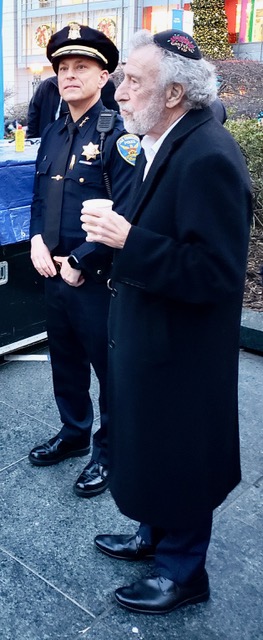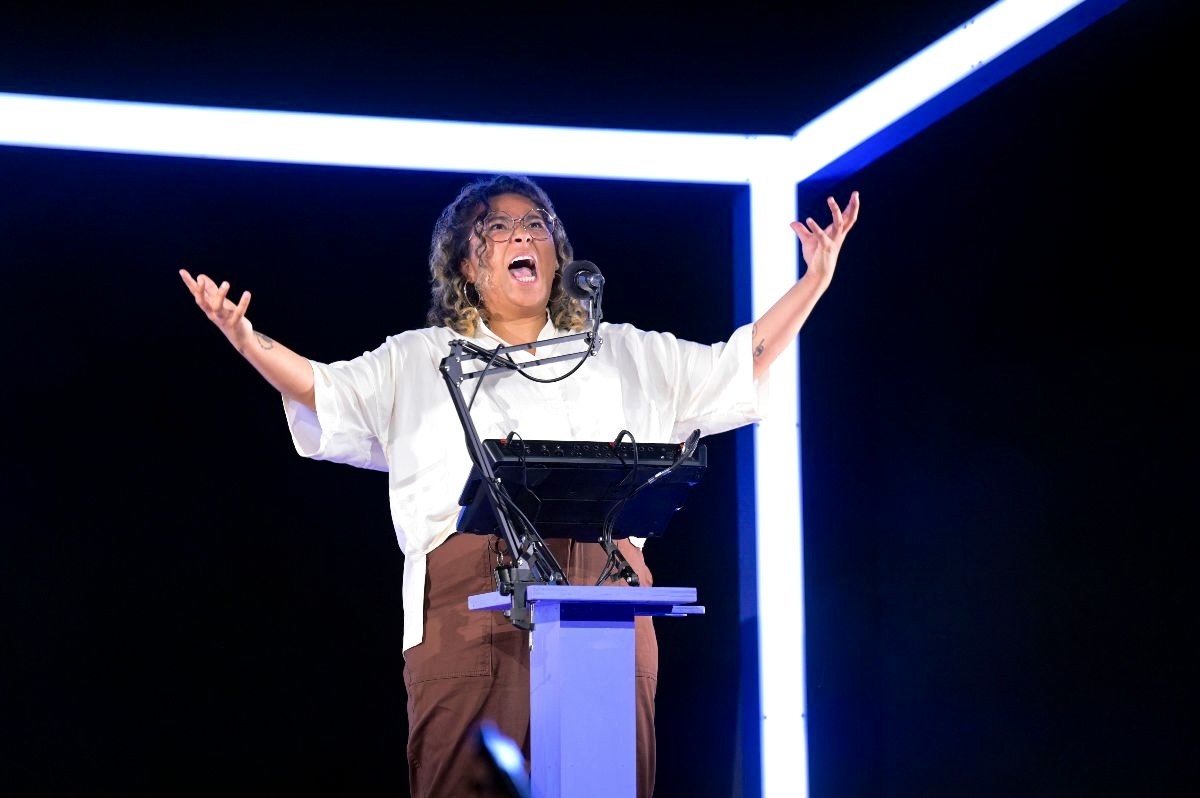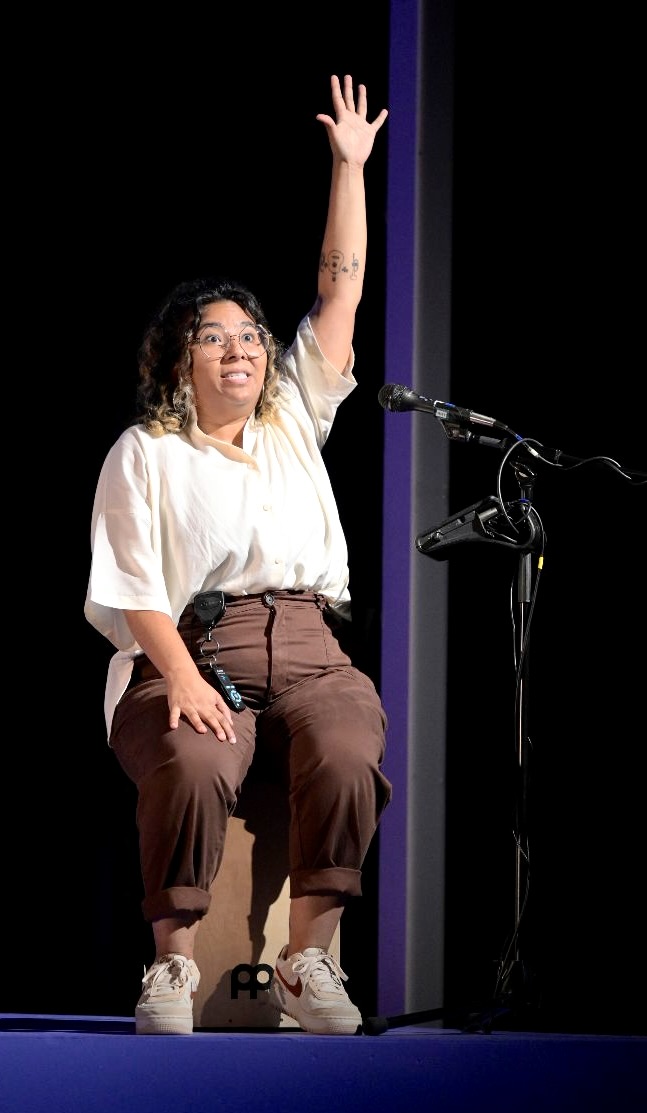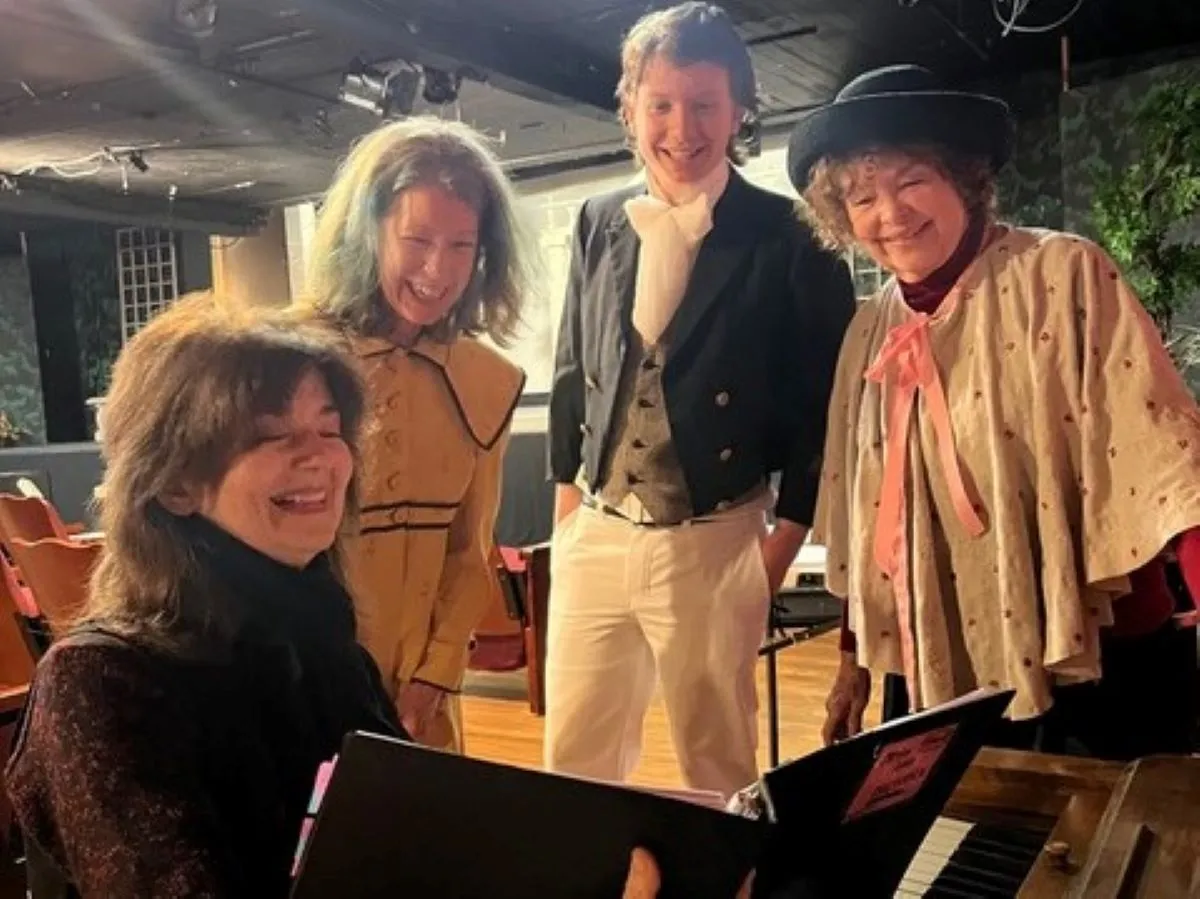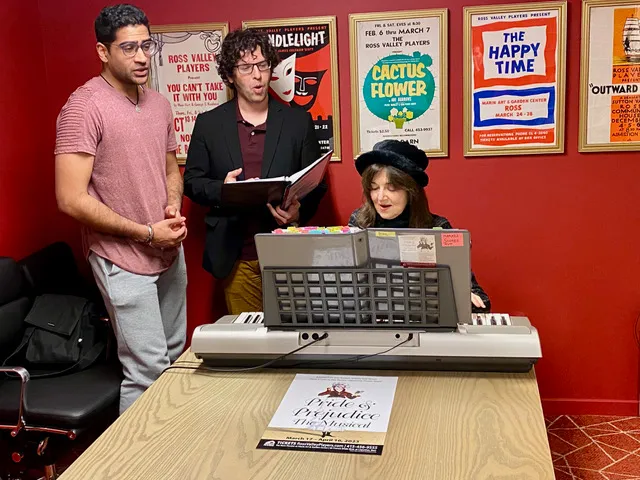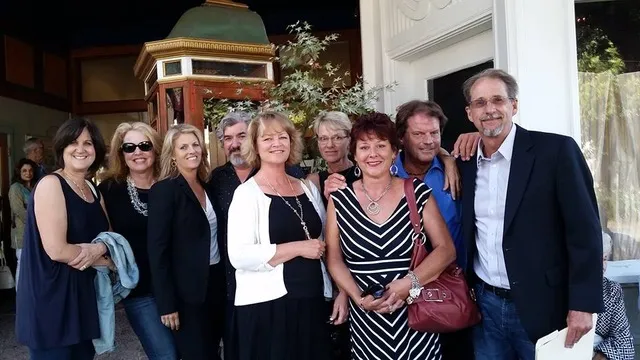
The cast of Masquers Playhouse’s “The People vs. Mona” includes, from left, Kamaria McKinney, Shay Oglesby-Smith, Steve Alesch, Arup Chakrabarti, Nelson Brown, Michele Sanner Vargas and Harrison Alter. (Courtesy Mark Decker)
“The People vs. Mona,” a zany musical comedy at the Masquers Playhouse in Point Richmond, deserves a needlepoint that labels it laugh-out-loud funny.
Or silly, sillier, silliest.
Because it can be tough to translate visual humor into the words of a review, it is suggested you get to a performance in the cozy (89-seat) theater to see for yourself.
“Mona’s” winning ingredients include exaggerated physical comedy and lyrics that evoke laughter almost every third line; music that ranges from country-rock to gospel (with a marching band tossed in for good measure); a multicultural cast of eight (half of whom play dual roles); a madcap plot by Patricia Miller that features a murder mystery (did Mona Mae Katt bludgeon her honeymooning husband to death with a glitzy guitar?), lots monkey business in the courtroom; and a touch of social commentary about changing an unobtrusive backwater town into a domicile for a shiny new casino.
Enrico Banson, who seamlessly directs the 105-minute “Mona” and inserted tons of unexpected schtick, doubles as an extraordinary musical director who’s onstage with his electronic keyboard throughout.
Michele Sanner Vargas is outstanding in the title role, bringing audience glee with her over-the-top facial and body distortions, not to mention her proficiency twirling a baton. Yet that’s topped by Kamaria McKinney, whose antics as Tish Thomas, a columnist and sex kitten, and blues singer Blind Willy, dare audience members not to smile.
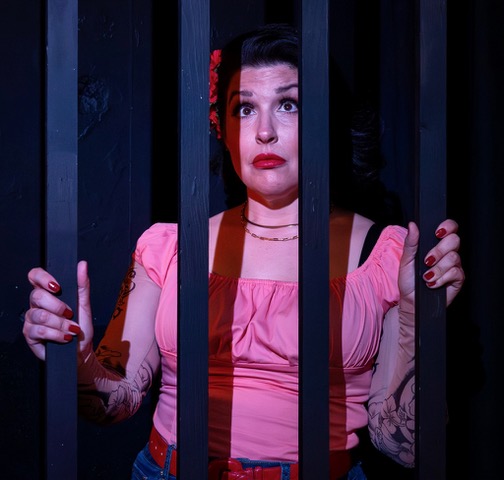
Steve Alesch plays Officer Bell with a pseudo-operatic voice and a face so comically rubbery it’s virtually impossible to look away even when there’s another in the spotlight.
Harrison Alter portrays the ninety-something Euple R. Pugh with a flailing level of energy that can make any senior in the crowd jealous.
And Nelson Brown as Mona’s attorney and a hand-waving narrator who involves audience members in rising from their seats, muttering and getting rowdy, also turns in a five-star performance.
The remainder of the cast — Shay Oglesby-Smith, Jeffrie Givens and Arup Chakrabarti — also deserves high praise, as does costume designer Mara Plankers Norleen, responsible for a terrific singing quartet of cats (caps with ears, gloves with fur and imprinted paws, bushy tails) and Mona’s outstanding look with full-length sleeves that replicate tattooed arms and cowgirl boots decorated with butterflies.
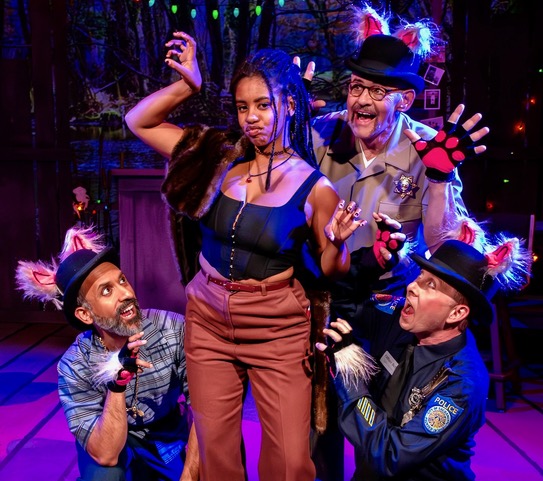
Choreographer Katherine Cooper has invented a series of ridiculous moves guaranteed to keep those grins coming.
The production’s location is Tippo, Georgia, in the Frog Pad, a honky-tonk owned by Mona that’s the oldest juke joint in the state and spurring a tune spotlighting a chorus of “Ribbit.”
The show’s campy music and clever lyrics are by the Tony Award-nominated Jim Wann, the primary composer of “Pump Boys and Dinettes,” a 1982 show that jet-streamed from downtown basements to Broadway (with a stopover off-Broadway) and spewed good-ole-boy wisdom via a county rock-pop score.
It’s exciting that the latest incarnation of “Mona” is here. It would be hard to find an Actors’ Equity show that’s better.
While more than few Bay Area theater companies have taken down their curtains recently due to rising costs and diminishing audiences triggered by continuing waves of COVID, “Mona” proves that small, community theaters are not only still viable but can thrive while producing first-rate ensemble entertainment.
“The People vs. Mona” runs through Nov. 26 at the Masquers Playhouse, 105 Park Place, Point Richmond. Tickets are $30 at (510) 232-4031 or https://masquers.org.







 Dede (left) doubts Ayamma’s acting abilities in Nollywood Dreams. Photo by Jessica Palopoli.
Dede (left) doubts Ayamma’s acting abilities in Nollywood Dreams. Photo by Jessica Palopoli. Adenikeh wears her emotions on her colorful sleeves. Photo by Jessica Palopoli.
Adenikeh wears her emotions on her colorful sleeves. Photo by Jessica Palopoli.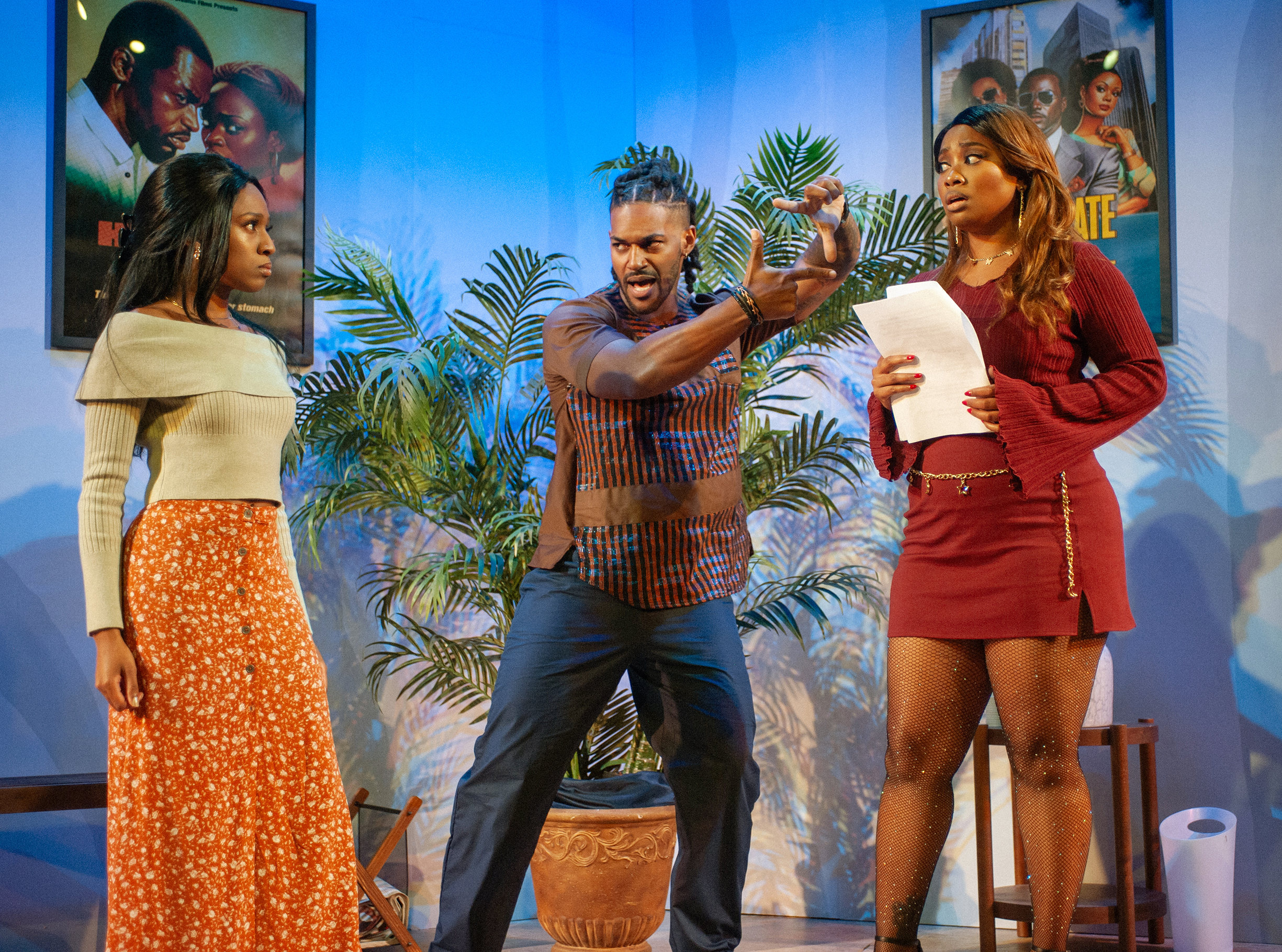 Ayamma (left) auditions for director Gbenga as fading diva Fayola waits her turn. Photo by Jessica Palopoli.
Ayamma (left) auditions for director Gbenga as fading diva Fayola waits her turn. Photo by Jessica Palopoli. Val Caniparoli’s “Tutto Eccetto Il Lavandino” is a highlight of Smuin’s “Dance Series 1” onstage in San Francisco through Oct. 7. (Courtesy Chris Hardy)
Val Caniparoli’s “Tutto Eccetto Il Lavandino” is a highlight of Smuin’s “Dance Series 1” onstage in San Francisco through Oct. 7. (Courtesy Chris Hardy) Smuin dancer Terez Dean Orr steps through (L-R) João Sampaio, Brandon Alexander and Ian Buchanan in James Kudelka’s Johnny Cash tribute, “The Man in Black.” (Courtesy Chris Hardy)
Smuin dancer Terez Dean Orr steps through (L-R) João Sampaio, Brandon Alexander and Ian Buchanan in James Kudelka’s Johnny Cash tribute, “The Man in Black.” (Courtesy Chris Hardy) Douglas Melini’s artwork is featured in the premiere of Darrell Grand Moultrie’s “Salsa ’til Dawn” in Smuin’s “Dance Series 1.” (Courtesy Chris Hardy)
Douglas Melini’s artwork is featured in the premiere of Darrell Grand Moultrie’s “Salsa ’til Dawn” in Smuin’s “Dance Series 1.” (Courtesy Chris Hardy) Chantell Jeannette-Black’s “I Dream” is among the artworks in the exhibit “The Only Door I Can Open: Women Exposing Prison Through Art and Poetry.” (Photo courtesy Minoosh Zomorodinia)
Chantell Jeannette-Black’s “I Dream” is among the artworks in the exhibit “The Only Door I Can Open: Women Exposing Prison Through Art and Poetry.” (Photo courtesy Minoosh Zomorodinia)



